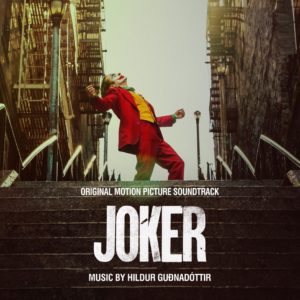
One name that keeps appearing in the soundtrack world lately is that of Icelandic composer Hildur Guðnadóttir. I first heard of her when her dear Icelandic friend and collaborator Jóhann Jóhannsson passed away. During the World Soundtrack Awards 2018, she accepted the composer of the year award on his behalf. A year later she received her own reward for best composer for television, mainly for her music on the television show Chernobyl. That was not the only award she received for that series, she also won a prestigious Emmy Award for it. The music for Chernobyl is quite interesting because she created an atmospheric score using only sounds she recorded at an abandoned nuclear reactor. For me personally, it was not really a score worth reviewing, since it was more sound design than a melodic soundtrack. After winning the Emmy I became quite curious about the music she had written for the much-anticipated movie from the DC superhero universe: Joker.
Guðnadóttir’s main instrument is the cello, which is also the main instrument for this score. On this 36 minute album, almost all the music is done by a handful of cellists, with occasional support from other string instruments and percussion. “Hoyt’s Office” sets the tone for the score very well, with a slow-paced melody over an extremely low string sound. “Defeated Clown” contains a pattern that can be heard occasionally in the movie, where the cellists go slightly up and down in melody with timpani beats in the background. In “Arthur Comes to Sophie,” the same pattern can be heard, but slightly darker and it sounds broader. The pattern returns again for the last time in “Subway.” In “Following Sophie” the cellos are played more aggressively, creating darker and sinister sounds.
“Hiding in the Fridge” is a bit of a weird track on this score. It sounds very artificial, unlike the cello, to which I have grown accustomed. I was convinced that the music was artificially made, but Guðnadóttir revealed in a recent interview that all the music in this score is played by musicians, including that track, which is mind-blowing to me. “Penny Taken to the Hospital” is also a bit of a strange track, since it is very happy sounding. The cello players create a wonderful atmosphere where some provide a pleasant foundation and others play a delightful melody on top of it.
While I was watching the movie, one scene really popped out to me musically, which can be heard in “Bathroom Dance.” In that scene, the Joker starts to dance to the music in a public bathroom after committing his first major crime. Only a couple of days after seeing the movie I found out why that was. Apparently, the scene was written to be totally different. However, for director Todd Phillips and Joaquin Phoenix, who plays the Joker, that version did not feel right. Guðnadóttir had written this track already and they decided to play it on the spot. The basis of this track is a single eerie sounding string instrument called the halldorophone, which Phoenix decided to dance to, creating this amazing scene. For me, this shows how music can influence a scene; not only in post-processing but even while shooting.
The last track on the album is “Call me Joker,” which is one of the longer tracks. It starts with thumping percussion, one eerie sounding cello – probably the halldorophone again – and high string sounds in the background. While the track progresses, more instruments start to join until a full orchestra helps the music reach its climax. After reaching the highest point, only the halldorophone ends the track – and with that the movie. This is the only time a full orchestra can be heard clearly on the whole album. There are hints of an orchestra in other parts of the soundtrack, but these are so well hidden you hardly notice them. The other tracks on the album that I did not mention, are more of ambient filler tracks, which are okay, but not much can be said about them.
After listening to the music for Chernobyl, I was afraid that the Joker score would also have a strong focus on sound design. I was glad to hear more melody in this score. Also, you can hear the human element of the musicians playing the cello in the music, highlighting the person behind the famous villain. The movie is very slow-paced and the music fits that. The movie is of very high quality, with the lighting, acting, direction and all the other things that are needed to create an amazing movie. However, I personally do not like such slow-paced movies, and when a movie is slow I always focus on the music to get me through the scene. The music Guðnadóttir wrote is perfectly executed, setting the mood and atmosphere for Arthur Fleck and his alter-ego the Joker, but it did not keep me from longing for the next scene to see where the story goes. I would not be surprised if the music would be nominated for an Oscar and Guðnadóttir even has a good chance of winning it. But personally, I just prefer a little bit more melody in my film music. If this type of minimal atmospheric score is your thing, you should definitely check this one out.
Listen or buy
- Buy this soundtrack from Amazon.com or iTunes
- Listen to this soundtrack on Spotify
Tracklist
The highlights are in bold.
- Hoyt’s Office (1:24)
- Defeated Clown (2:39)
- Following Sophie (1:33)
- Penny in the Hospital (1:18)
- Young Penny (2:01)
- Meeting Bruce Wayne (4:35)
- Hiding in the Fridge (1:23)
- A Bad Comedian (1:28)
- Arthur Comes to Sophie (1:39)
- Looking for Answers (0:51)
- Penny Taken to the Hospital (1:49)
- Subway (3:33)
- Bathroom Dance (2:08)
- Learning How to Act Normal (1:17)
- Confession (1:29)
- Escape from the Train (2:31)
- Call Me Joker (4:48)
Total length: 36 minutes
Watertower Music (2019)




